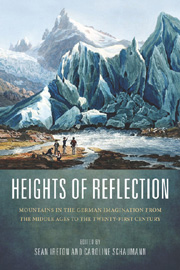 Heights of Reflection
Heights of Reflection Book contents
- Frontmatter
- Contents
- Acknowledgments
- Introduction: The Meaning of Mountains: Geology, History, Culture
- Prelude: Classical Mountain Landscapes and the Language of Ascent
- Part I First Forays: Mountain Exploration and Celebration from the Middle Ages to the Eighteenth Century
- Part II Beckoning Heights: Summits Near and Far in the Nineteenth Century
- Part III Modern Expeditions and Evocations: Climbing from the Twentieth into the Twenty-First Century
- Leaving the Summit Behind: Tracking Biographical and Philosophical Pathways in Richard Strauss's Eine Alpensinfonie
- Elevation and Insight: Thomas Mann's Der Zauberberg
- “The Essence of the Alpine World Is Struggle”: Strategies of Gesundung in Arnold Fanck's Early Mountain Films
- “Mountain of Destiny”: The Filmic Legacy of Nanga Parbat
- Spatial Orientation and Embodied Transcendence in Werner Herzog's Mountain Climbing Films
- W. G. Sebald's Magic Mountains
- Conflicting Ascents: Inscriptions, Cartographies, and Disappearance in Christoph Ransmayr's Der fliegende Berg
- Works Cited
- Notes on the Contributors
- Index
W. G. Sebald's Magic Mountains
from Part III - Modern Expeditions and Evocations: Climbing from the Twentieth into the Twenty-First Century
Published online by Cambridge University Press: 05 February 2013
- Frontmatter
- Contents
- Acknowledgments
- Introduction: The Meaning of Mountains: Geology, History, Culture
- Prelude: Classical Mountain Landscapes and the Language of Ascent
- Part I First Forays: Mountain Exploration and Celebration from the Middle Ages to the Eighteenth Century
- Part II Beckoning Heights: Summits Near and Far in the Nineteenth Century
- Part III Modern Expeditions and Evocations: Climbing from the Twentieth into the Twenty-First Century
- Leaving the Summit Behind: Tracking Biographical and Philosophical Pathways in Richard Strauss's Eine Alpensinfonie
- Elevation and Insight: Thomas Mann's Der Zauberberg
- “The Essence of the Alpine World Is Struggle”: Strategies of Gesundung in Arnold Fanck's Early Mountain Films
- “Mountain of Destiny”: The Filmic Legacy of Nanga Parbat
- Spatial Orientation and Embodied Transcendence in Werner Herzog's Mountain Climbing Films
- W. G. Sebald's Magic Mountains
- Conflicting Ascents: Inscriptions, Cartographies, and Disappearance in Christoph Ransmayr's Der fliegende Berg
- Works Cited
- Notes on the Contributors
- Index
Summary
Mountains are everywhere in W. G. Sebald's prose, from the very first image of the Grand St. Bernard, which appears even before the opening words of the text of the story “Beyle oder das merckwürdige Faktum der Liebe” (Beyle, or the strange fact of love), to “Die Alpen im Meer” (Alps in the sea). The former image, in “Beyle,” introduces the story of Napoleon's army's march across the Col-St.-Bernard in 1800, and, rather than the obvious image that comes to mind for us in that context — Jacques-Louis David's equestrian portrait of Le Premier Consul pointing the way ahead over the pass, painted that same year — we find in Sebald's story instead a poor reproduction of an unattributed etching that depicts thousands of miniscule soldiers and riders trekking up the pass toward the massive and imposing mountain in the distance.
Fast vierzehn Tage lang bewegte sich ein unabsehbarer Zug von Menschen, Tieren und Material von Martigny aus über Orsières durch das Tal von Entremont und sodann in endlos scheinenden Serpentinen hinauf auf die zweieinhalbtausend Meter über dem Spiegel des Meeres liegende Höhe des Passes (7)
[For almost a fortnight, an interminable column of men, animals and equipment proceeded from Martigny via Orsières through the Entremont valley and from there moved, in a seemingly never-ending serpentine, up to the pass two and a half thousand metres above sea level. (3)]
- Type
- Chapter
- Information
- Heights of ReflectionMountains in the German Imagination from the Middle Ages to the Twenty-First Century, pp. 320 - 333Publisher: Boydell & BrewerPrint publication year: 2012
